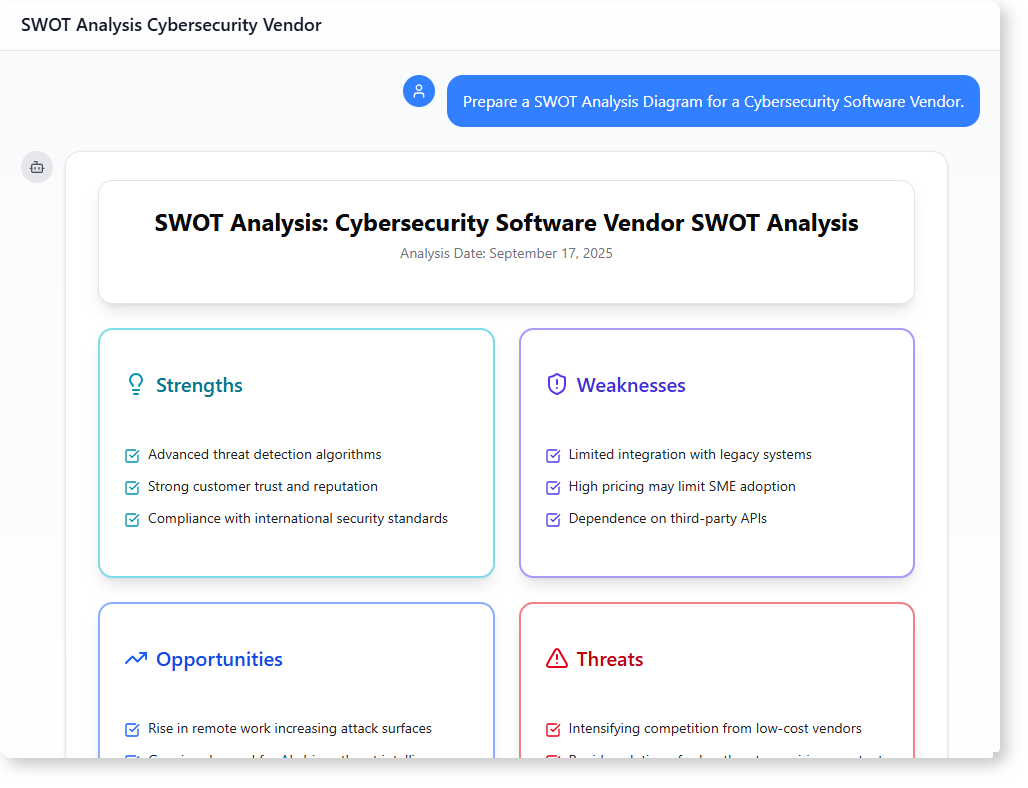Now Reading: How AI-Powered Modeling Software Creates a Cybersecurity SWOT Diagram in Minutes
-
01
How AI-Powered Modeling Software Creates a Cybersecurity SWOT Diagram in Minutes
How AI-Powered Modeling Software Creates a Cybersecurity SWOT Diagram in Minutes
Why a Cybersecurity Vendor Needs a SWOT Analysis
A cybersecurity software vendor must constantly assess their internal position and external risks. Without clear insight, decisions on product development, pricing, or market entry can miss the mark.
This is where an AI-powered modeling software becomes a strategic asset. By asking the right question — like ‘Prepare a SWOT Analysis Diagram for a Cybersecurity Software Vendor’ — the tool generates a structured, visual breakdown of strengths, weaknesses, opportunities, and threats.
This isn’t just a list. It’s a clear picture of where the vendor stands and where it should go.

The User’s Journey: From Prompt to Narrative Report
A mid-level manager at a growing cybersecurity firm wanted to understand their company’s position in the market. They weren’t looking for a generic SWOT. They needed something grounded in real-world challenges.
They began by asking the AI-powered modeling software:
‘Prepare a SWOT Analysis Diagram for a Cybersecurity Software Vendor.’
The tool responded by generating a detailed SWOT structure, organized by categories: Strengths, Weaknesses, Opportunities, and Threats. Each section included specific, actionable insights.
After reviewing the diagram, they followed up with a second prompt:
‘Turn this diagram into a narrative report that tells the story behind the structure.’
The AI didn’t just list points. It interpreted the relationships between them. It explained how strong customer trust connects to market resilience, how rising remote work creates new attack surfaces, and why evolving regulations could shift the competitive balance.
This wasn’t a mechanical response. It was a story — one that a board or a product team could actually use to guide strategy.
What the AI-Powered Modeling Software Delivers
The result is more than a diagram. It’s a smart, contextual analysis that helps leaders:
- Identify internal advantages that build customer confidence
- Spot integration gaps that block growth
- Recognize emerging market trends like AI-driven threat intelligence
- Prepare for external pressures like new regulations or rising competition
For example:
- Strengths such as advanced threat detection and compliance with international security standards show technical credibility and trust.
- Weaknesses like dependency on third-party APIs and high pricing reveal barriers to adoption, especially for small businesses.
- Opportunities like expanding into cloud and IoT security reflect growing market needs.
- Threats such as intensifying competition and evolving cyber threats highlight the need for continuous innovation.
This level of insight helps avoid blind spots. It turns abstract concepts into real-world decisions.
How This Changes Strategic Planning
Traditional SWOT tools require hours of manual work. A team might spend time gathering data, categorizing it, and formatting it into a slide. With AI-powered modeling software, the process is immediate and intuitive.
No need to collect data from spreadsheets or interviews. Just describe the scenario. The tool does the rest.
This approach is especially useful for:
- Internal reviews before product launches
- Planning responses to regulatory changes
- Preparing vendor narratives for investor meetings
The output is a narrative report that reads like a strategic document — not a checklist.
Is This a SWOT Analysis Tool? Yes. But It’s Smarter.
Many tools offer a SWOT Analysis software or even a SWOT diagram generator. But most stop at listing points.
This AI-powered modeling software doesn’t just generate a diagram. It understands context. It interprets patterns. It turns raw data into a story.
It’s not just a SWOT Analysis tool — it’s an AI Chatbot for SWOT Analysis that thinks like a strategist.
Because of this, it becomes a valuable part of a vendor’s narrative, especially when creating a Cybersecurity vendor narrative report.
Real-World Impact
The manager used the output to present a clearer picture of the company’s market position to the executive team. The narrative included a timeline of threats, a comparison of internal capabilities, and a clear path for growth.
The feedback was positive. The team now uses the same workflow for new product reviews and competitive assessments.
Frequently Asked Questions
What makes this SWOT analysis different from others?
Most SWOT tools offer a static list. This one produces a dynamic, story-driven insight that shows how each element connects to the others.
Can I use this for other types of organizations?
Yes. The same approach works for software vendors, SaaS platforms, or any business that needs to assess its position in a competitive environment.
How does the AI understand the context?
The AI uses pattern recognition and contextual reasoning. It doesn’t rely on predefined templates. Instead, it interprets the nature of the industry — like cybersecurity — and applies relevant insights.
Is this a standalone report or part of a larger system?
It functions as a standalone narrative. However, it can be easily integrated into presentations, pitch decks, or internal strategy sessions.
Ready to map out your system’s interactions? Give our AI-powered modeling software a try at Visual Paradigm’s AI Chatbot today!
